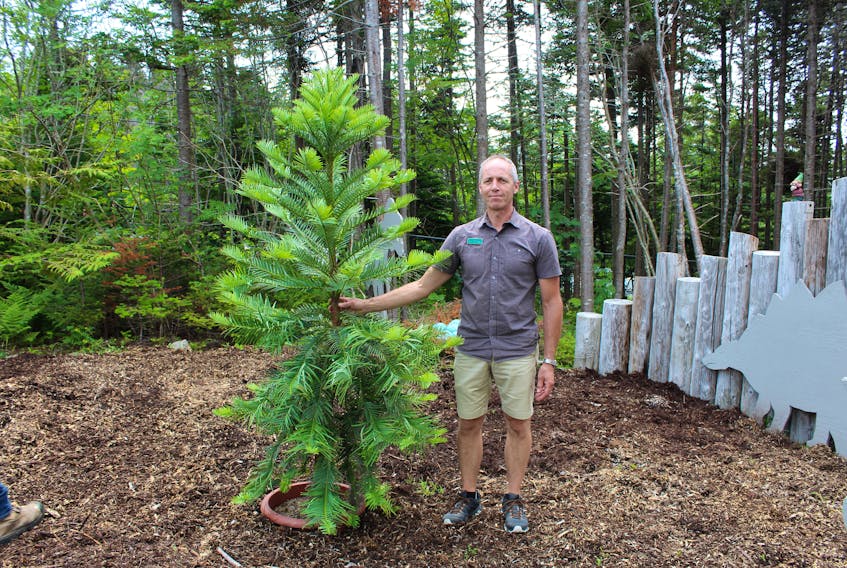ST. JOHN'S, N.L. - The rediscovery of the Wollemi pine in 1994 is the arboreal equivalent to finding a baby dinosaur strolling in some far-off wilderness. The tree, which dates back to the Jurassic period, was known solely from fossil records to that point.
In the early 1990s, David Noble, an adventurous bushwalker and mountain climber in Australia, was in a remote part of Wollemi National Park with steep sandstone gorges, located in the Blue Mountains of Australia, about 150 kilometres west of Sydney, when he came across a rare tree. He took some samples back with him. Scientists compared the samples to known fossils dating from as much as 200 million years ago and found it was a match. There is no genetic diversity among the 36 plants in the region where they were discovered, the only place on Earth they are naturally occurring.
The tree, Wollemis Nobilis, was named in part after the park and part after the man who found it. Despite being labelled as a pine tree, it is in fact part of the Araucariaceae family. This family includes the Monkey puzzle tree and the Norfolk Island pine. Unlike members of the pine family, the Wollemi pine does not have needles, but instead pendulous bottle-brush foliage.

“At this point, nobody seems to know why it has survived. Obviously, there’s something in that valley that’s either giving it something that it needs or has isolated it from something that would have caused its demise,” says horticulturalist Tim Walsh, the nursery manager at the Memorial University Botanical Garden.
After the initial discovery, the tree was kept a secret for several years out of fear it might be damaged or stolen by rare plant collectors. Wollemi National Park hired a nursery to propagate the plant. The propagated plants were sent first around Australia and then to other parts of the world.
It is common practice among conservationists to send propagated plants to different botanical gardens in order to increase the distribution of a plant and to protect and ensure its longevity. This way, there is a backup in case something should happen to the native population.
Some of the propagated Wollemi pines were distributed in Canada, and an avid gardener and supporter of the Memorial University Botanical Garden got one. After caring for it for about four years, she donated it to the botanical garden. The tree will be unveiled in its new summer home on Saturday, July 21, at 11 a.m.
Walsh recalls that the tree was only 30-40 centimetres tall when the botanical garden received it about six years ago. Today it is about 10 years old and more than six feet tall. Walsh explained that while it is difficult to predict how tall the tree will grow, it is unlikely it will get to be the 50-60 feet Wollemi pines reach in the wild.
“We could see the plant eventually overgrowing our space, but what we’re going to be looking at now is how do we propagate it,” Walsh said, adding that the botanical garden’s greenhouse is 12 feet high at its highest point.
“We’re going to protect it during winter times,” Walsh said, explaining that the tree grows in a sub-tropical environment in Australia, and although it can survive -12 C temperatures, winters in St. John’s can get colder than that and the dry wind is likely to kill the plant.
The Wollemi pine will be kept outside until the botanical garden closes in November, and then moved back to the greenhouse.
“I think there’s all kinds of mystery associated with it and it’s always nice to unlock a little bit of that,” Walsh says about the journey of the Wollemi pine from Australia to Newfoundland. “This plant was not known to be living or surviving at all on the planet.
“I think it’s just an appreciation for life on our planet, really. Quite often when we find something that’s rare, I think it just makes us all think about our footprint, and makes us think about the way we live and the world around us. Things come and go and it’s important to recognize that the planet is always changing. Sometimes we can learn that it’s changing and it could be a negative and that we’re actually affecting it.”
The Wollemi pine provides an opportunity to think about what can be done to nurture a safer environment for rare and endangered plants, including those particular to Newfoundland, he said.
Set for Saturday’s unveiling, the Friends of the Garden carpenter group has created dinosaur silhouettes and eggs and placed them throughout the garden and around the Wollemi pine’s area to help people think about the relationship between the extinct animals and living fossils.
The unveiling will include a talk about the Wollemi pine and its history, tours, a conservation pledge and games.









